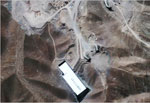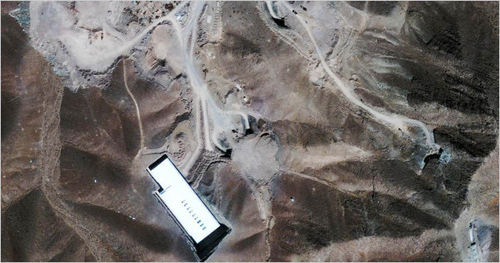 AP: In a show-and-tell based on secret intelligence, the U.N. atomic agency shared satellite images, letters and diagrams with 35 nations Friday as it sought to underpin its case that Iran apparently worked secretly on developing a nuclear weapon.
AP: In a show-and-tell based on secret intelligence, the U.N. atomic agency shared satellite images, letters and diagrams with 35 nations Friday as it sought to underpin its case that Iran apparently worked secretly on developing a nuclear weapon.
The Associated Press
By GEORGE JAHN, Associated Press
 VIENNA (AP) — In a show-and-tell based on secret intelligence, the U.N. atomic agency shared satellite images, letters and diagrams with 35 nations Friday as it sought to underpin its case that Iran apparently worked secretly on developing a nuclear weapon.
VIENNA (AP) — In a show-and-tell based on secret intelligence, the U.N. atomic agency shared satellite images, letters and diagrams with 35 nations Friday as it sought to underpin its case that Iran apparently worked secretly on developing a nuclear weapon.
Iran’s chief envoy to the International Atomic Energy Agency rejected the presentation as based on material fabricated by the United States and its allies.
“There is no indication and proof that Iran’s activities is toward military purposes,” he told reporters, in comments that those inside the closed meeting showing the evidence said essentially matched his statement to that gathering.
Western diplomats, in contrast, said that the briefing was a convincing supplement to a report presented earlier this week.
Based on 1,000 pages of research and nearly a decade of probing Iran, that document included evidence that the agency says indicates the Islamic republic is working on the clandestine procurement of equipment and designs to make nuclear arms.
“While some of the activities identified in the annex have civilian as well as military applications, others are specific to nuclear weapons,” the report said.
Among these were indications that Iran has conducted high explosives testing and detonator development to set off a nuclear charge, as well as computer modeling of a core of a nuclear warhead. The report also cited preparatory work for a nuclear weapons test, and development of a nuclear payload for Iran’s Shahab 3 intermediate range missile — a weapon that can reach Israel.
The report also implicated a “foreign expert” as helping Tehran on some of its alleged experiments, saying he worked on ways to set off a nuclear blast through a sophisticated multipoint explosives trigger.
But there are indications, not mentioned in the report, that the expert — identified by diplomats and media reports as former Soviet scientist Vyacheslav Danilenko — was even more deeply involved.
Ahead of Friday’s meeting, diplomats told The Associated Press that Danilenko’s son-in-law has told the agency Danilenko also helped Iran build a related project, a large steel chamber to contain the force of the blast set off by such explosives testing.
Diplomats first told the AP last week that the IAEA had evidence of such a chamber, set up at Iran’s Parchin military complex. The confidential IAEA report obtained by the AP on Wednesday confirmed their statements.
It said Iran constructed “a large explosives containment vessel” in which to conduct experiments on triggering a nuclear explosion, apparently 11 years ago, adding that it had satellite images “consistent with this information.”
The diplomats said the briefing Friday was shown those images — and other visual intelligence it has based its probe on. Next week, a board session will focus on concerns that Iran may be seeking to develop nuclear weapons — something Tehran vehemently denies.
The diplomats said some of those at the meeting also expressed their concerns about indications that nearly 20 kilograms — about 45 pounds — of a component used to arm nuclear warheads was unaccounted for in Iran.
The IAEA has long known that Iran has drawings of how to form uranium metal into the fissile core of warheads. But the diplomats pointed to an inconspicuous section of Wednesday’s report — near the end, under “Other Matters” — revealing that an IAEA inspection in August came up 19.8 kilograms, or 43.56 pounds, short of what Iran says it had stored.
One diplomat said that amount of the metal — which can also be used to make uranium fuel — would be enough to arm a nuclear bomb. The agency said it was studying Iran’s explanation for the discrepancy.
On Danilenko, another diplomat who is familiar with the IAEA’s Iran probe said the scientist told the agency that he did not work on such a chamber. That, said the diplomat, directly contradicts a statement by his son-in-law, who said the container was built under Danilenko’s direct supervision.
The diplomat did not name the son-in-law, but a nuclear expert familiar with the issue identified him as Vladimir Padalko.
Danilenko, 76, pioneered the process that uses explosions to create tiny diamonds for a range of industrial uses — technology similar to the multipoint explosives trigger the IAEA suspects him of working on in the 1990s.
A third diplomat — who like the others asked for anonymity because his information was privileged — said sections from a book on diamond manufacture published last year by Danilenko were presented at the briefing. He said the process described in the book was almost exactly that used for the multipoint explosions to set off a nuclear blast.
As well, he said diagrams of chambers used in the diamond-making process bore “an uncanny resemblance” to the container the IAEA says appears to have been employed for Iran’s nuclear-related explosives tests.
Padalko is the director of Alit, a Ukrainian company that produces such diamonds. The Russian daily Kommersant said after the 1991 collapse of the Soviet Union, Danilenko was employed for several years by Alit. It cited Padalko as saying that experts from the IAEA and the U.S. State Department had met with Danilenko several times in recent years.
Efforts to reach the two men Friday were unsuccessful.
Danilenko went public with his denial Thursday, telling Kommersant: “I am not a nuclear scientist and I am not the founder of the Iranian nuclear program.”
The diplomat said he told IAEA experts that he thought his work was limited to assisting civilian engineering projects.
The IAEA report cited intelligence from a nation it did not name, saying the “foreign expert” worked “for much of his career” in developing explosive triggers for a nuclear blast in his home country.
It said the expert was in Iran from about 1996 to about 2002, ostensibly to help Iran develop a technique to make the tiny industrial diamonds. The process also uses steel chambers, but one of the diplomats said the one at Parchin — described as the size of a double-decker bus — was much too large for this use.
Kommersant said that starting in the 1950s and until his retirement, Danilenko had worked at one of the Soviet Union’s top nuclear weapons research centers, known as Chelyabinsk-70.
Iran is under U.N. sanctions for refusing to stop uranium enrichment — which can produce both nuclear fuel and fissile warhead material — and other suspected activities that the international community fears could be used to make atomic arms. It dismisses such allegations and says its activities are meant to be used only for energy or research.
But the IAEA report strongly suggested that Iran is using the cover of a peaceful nuclear program to produce atomic weaponry. Based on years of trying to probe Tehran’s secretive activities, its release will stoke debate on whether it’s time to jettison failed diplomatic efforts to end Iran’s nuclear defiance and replace them with force.
___
Maria Danilova in Kiev, Ukraine, and Vladimir Isachenkov and Lynn Berry in Moscow contributed to this report.
George Jahn can be reached at http://twitter.com/georgejahn


